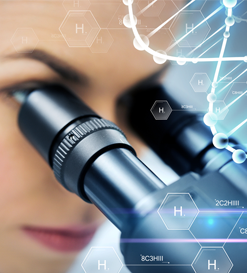BRCA1 and BRCA2 gene mutation – treatment and prophylaxis

Breast cancer is the most common malignant cancer in women. It is estimated that breast cancer accounts for 25.1% of all worldwide cases of cancers in women. Unfortunately, women’s awareness of breast disease prophylaxis is still very low. Women tend to wait too long to visit specialist physicians – they often only do so when it is too late and the disease is already in its advanced stages. If women performed breast self-examination and underwent screening test more often, the incidence of breast cancer could be significantly reduced.
Breast cancer symptoms
In its early stage, breast cancer is usually asymptomatic or the symptoms are so insignificant that they are ignored by most women. Women most often visit the doctor after finding a lump upon breast self-examination. It is worth noting that a nodule in the armpit may also be symptom of breast cancer.
Regular, monthly breast self-examination at home is one of key steps of breast cancer prophylaxis.
During the examination, particular attention should be paid to:
the changes in breast appearance or shape;
breast asymmetry;
thickening / lump in the breast;
change in breast colour / skin redness;
nipple retraction;
nipple discharge;
changes in nipple appearance (including puckering of the nipple skin or changes around nipples);
ulcerations.
Not every change implies the presence of breast cancer. Most symptoms turn out to be benign. However, no alarming symptom should be ignored and all doubts must be consulted with the physician.
Breast examination
While following the breast cancer prophylaxis recommendations will not save a woman from becoming ill, regular examinations allow disease diagnosis at the earliest possible stage. This translates directly into the course and efficiency of treatment.
Breast cancer prophylaxis includes mainly self-examination, breast ultrasound and mammography. These examinations should be known to all women and should be undertaken regularly. If the results reveal any irregularities, the physician may order breast biopsy or magnetic resonance imaging.
Women can also self-examine their breast each month using the innovative Braster device.
Examination schedule:
20–39 years – breast self-examination every month, breast examination by gynaecologist every 36 months.
40–49 years – breast self-examination every month, breast examination by gynaecologist every 12 months.
50–69 years – breast self-examination every month, breast examination by gynaecologist every 12 months, mammography every 24 months.
70 years and more – breast self-examination every month, breast examination by gynaecologist every 12 months.
Examination schedule for women with genetic predispositions:
Monthly breast self-examination by palpation.
Breast examination by a gynaecologist every 6 months.
In women under 30 years of age, MRI should be performed every 6 months, and if the result is ambiguous, mammography is recommended.
In women over 30 years of age, mammography should be performed every 6 months alternately with MRI and breast ultrasound which should be repeated every 12 months as a supplementary examination.
Zostaw swój numer, oddzwonimy i odpowiemy na Twoje pytania
I consent to the use of telecommunication end devices by BRASTER S.A. for commercial purposes and direct marketing, pursuant to Article 172 of the Act of July 16, 2004 – Telecommunications Law and the Act of July 18, 2002 on electronic provision of services. In particular, I consent to receiving incoming phone calls from BRASTER S.A. I declare that I have been informed that the above consent is voluntary and may be revoked at any time.
Strona http://braster.eu/nl realizuje sprzedaż jedynie na terenie Holandii. Jeżeli chcesz zrealizować zamówienie na terenie Polski przejdź na http://braster.eu/pl
I consent to the use of telecommunication end devices by BRASTER S.A. for commercial purposes and direct marketing, pursuant to Article 172 of the Act of July 16, 2004 – Telecommunications Law and the Act of July 18, 2002 on electronic provision of services. In particular, I consent to receiving incoming phone calls from BRASTER S.A. I declare that I have been informed that the above consent is voluntary and may be revoked at any time.
Your message was sent.
We will reply as soon as possible.
Raty PayU to możliwość zapłacenia za zakupy w ratach (od 3 do nawet 36)
Sign In
Create New Account